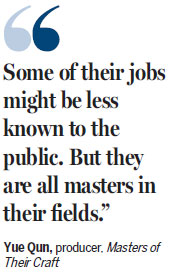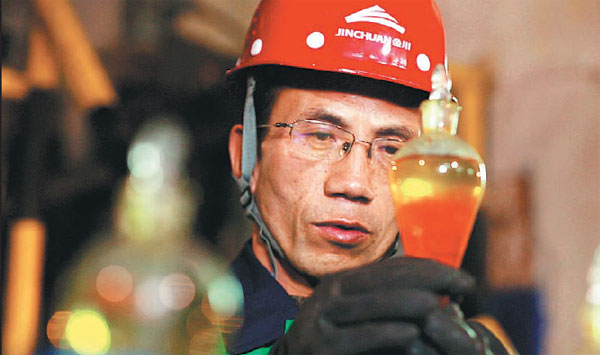Craft and life
TV program honors the tireless efforts of Chinese in different fields, Xu Fan reports.
Few Chinese from the younger generations know the story behind the 1 yuan coin.
In 1985, Yu Min, a designer at the Shanghai branch of China Banknote Printing and Minting Corp, beat a dozen aspirants to engrave the coin.
Then 26 years old, he had spent a few years on polishing the coin's plaster mold. In 1992, the coin, with the pattern of a peony flower, was officially circulated but overtaken by a version featuring a chrysanthemum in the 2000s.
|
Pan Congming is an expert in precious metals. His story is featured in a TV program called Masters of Their Craft. Photos Provided to China Daily |
In his long career, Yu has designed and engraved more than 100 types of coins and souvenirs such as those for Chairman Mao's 100th birth anniversary, others resembling medals of the 2008 Beijing Olympics and few more with Panda designs on them.
He became the first Chinese to win the lifetime achievement award in coin design from the World Coin News magazine and World Money Fair, a global numismatic and precious metals convention.
His decadeslong devotion to China's coin-engraving industry was recently reported in the fifth season of the Masters of Their Craft program aired on CCTV-1 and CCTV-13. He was featured in one episode.
The other four episodes featured the metal-refining worker Pan Congming, bianzhong (chime bells) tuner Liu Younian, milling technician Han Liping and engineer Qiao Sukai.
"Some of their jobs might be less known to the public. But they are all masters in their fields and should be known to more people," says Yue Qun, the program's producer.
Pan, 43, is an expert in China's precious metal industry.
Such metals as palladium and osmium are key materials in the production of cutting-edge weapons, but China has limited reserves of these.
"It means that recycling - what is done by workers like Pan - is very important to China's military industry," says Yue.
Every year, Pan and more than 100 co-workers in a factory under the Gansu-based Jinchuan Group, extract such metals from industrial waste, which accounts for around 50 percent of China's total production of these metals.
While accuracy is a must-have for Yu, Qiao, an engineer from the Guangdong-based Daya Bay Nuclear Power Plant, undertake risks in his daily work. One of his major jobs is to check and fix nuclear rods, which may cause a huge disaster if a minor error occurs. Qiao, 45, and his teammates wear protective clothing and masks to do their work.
To fix a damaged rod sometimes takes 10 hours or more.

Some comments on the streaming site bilibili.com hail Qiao and his team as heroes of this era.
The story of Liu, a bianzhong tuner in Wuhan, has added an artistic flavor to the TV program.
Bianzhong is an ancient Chinese musical instrument consisting of a set of bronze bells, which thrived around 3,000 years ago but mostly disappeared after the Tang Dynasty (618-907).
Liu, 60, has made bianzhong replications based on archaeological discoveries and has tuned the replicas to play harmoniously along with some modern instruments.
Wen Weimin, the editor behind the episode on Han, a milling technician at China Aerospace Science and Technology Corp, calls her story inspirational.
Han, 42, uses digitally-controlled milling machines to produce parts of rocket launchers.
She has won many awards for her dedication to China's aerospace industry.
"It was very difficult to explain what Han and her team exactly do, because it's technical stuff. We talked to dozens of people in the relevant field and used some metaphors to make the program more appealing to common viewers," says Wen.
Having taken part in the production of three seasons of Masters of Their Craft, Wen says the interviews have enlightened her. The subjects seem to care less about money and fame, and passionately work to pursue the best.
Yue, the producer of the program, says such stories can tell the world about the rise of quality productions and professionals in China.
She recalls that the inspiration for the program came from an elderly man, who insisted on making transistor radios by hand for decades.
"When speaking about craftsmanship spirit, some people in China might think about Swiss watchmakers or Japanese sushi chefs. But we have our own such veterans," she says.
By reading comments online, Yue says she has found that the program has influenced a number of young viewers, who say they can now take up vocational learning as well.
Statistics from the broadcaster show that one of the most popular seasons has been watched nearly 300 million times online and generated 180,000 reviews on Sina Weibo, the Chinese equivalent of Twitter.
In the past two years, many reporters and photographers of the TV channel have traveled to Shaanxi, Guizhou, Henan and the Inner Mongolia autonomous region, among other parts of the country to interview 52 craftsmen and women for the program.
Contact the writer at xufan@chinadaily.com.cn

(China Daily 05/30/2017 page8)





















